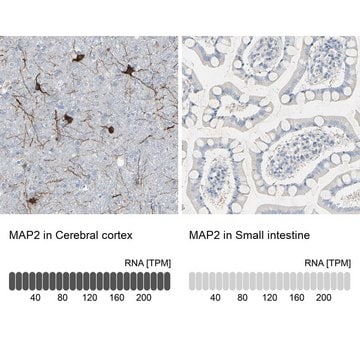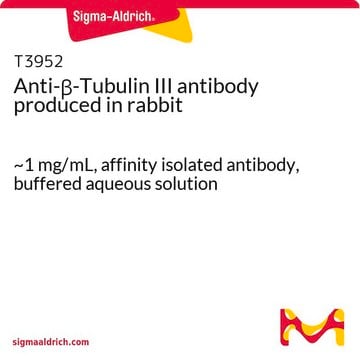M2320
Anti-MAP2 (2a+2b) antibody, Mouse monoclonal
~2 mg/mL, clone AP-20, purified from hybridoma cell culture
Synonim(y):
Anti-MAP2 (2a+2b) antibody, Mouse monoclonal, Anti-Microtubule Associated Protein 2
About This Item
Polecane produkty
pochodzenie biologiczne
mouse
Poziom jakości
białko sprzężone
unconjugated
forma przeciwciała
purified from hybridoma cell culture
rodzaj przeciwciała
primary antibodies
klon
AP-20, monoclonal
Postać
buffered aqueous solution
masa cząsteczkowa
apparent mol wt 280 kDa
reaktywność gatunkowa
Xenopus, mouse, quail, human, bovine, rat, aquatic salamander
opakowanie
antibody small pack of 25 μL
stężenie
~2 mg/mL
metody
immunocytochemistry: suitable
microarray: suitable
western blot: 1-3 μg/mL using rat brain preparation or rat cerebral cortex extract
izotyp
IgG1
numer dostępu UniProt
Warunki transportu
dry ice
temp. przechowywania
−20°C
docelowa modyfikacja potranslacyjna
unmodified
informacje o genach
human ... MAP2(4133)
mouse ... Mtap2(17756)
rat ... Map2(25595)
Szukasz podobnych produktów? Odwiedź Przewodnik dotyczący porównywania produktów
Opis ogólny
Specyficzność
Immunogen
Zastosowanie
Działania biochem./fizjol.
Postać fizyczna
Oświadczenie o zrzeczeniu się odpowiedzialności
Not finding the right product?
Try our Narzędzie selektora produktów.
polecane
Kod klasy składowania
10 - Combustible liquids
Klasa zagrożenia wodnego (WGK)
WGK 2
Temperatura zapłonu (°F)
Not applicable
Temperatura zapłonu (°C)
Not applicable
Certyfikaty analizy (CoA)
Poszukaj Certyfikaty analizy (CoA), wpisując numer partii/serii produktów. Numery serii i partii można znaleźć na etykiecie produktu po słowach „seria” lub „partia”.
Masz już ten produkt?
Dokumenty związane z niedawno zakupionymi produktami zostały zamieszczone w Bibliotece dokumentów.
Klienci oglądali również te produkty
Nasz zespół naukowców ma doświadczenie we wszystkich obszarach badań, w tym w naukach przyrodniczych, materiałoznawstwie, syntezie chemicznej, chromatografii, analityce i wielu innych dziedzinach.
Skontaktuj się z zespołem ds. pomocy technicznej












